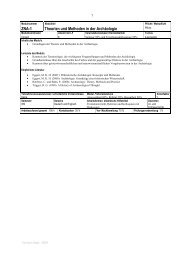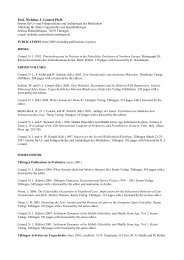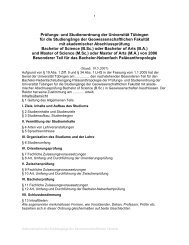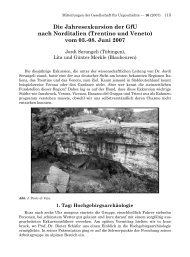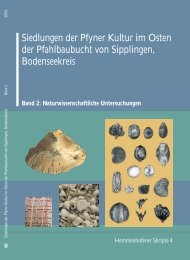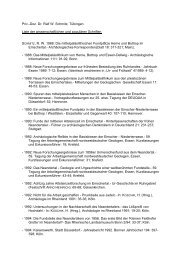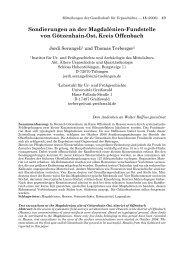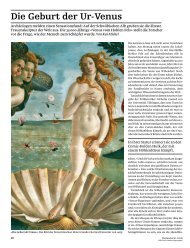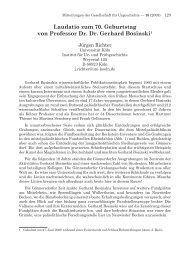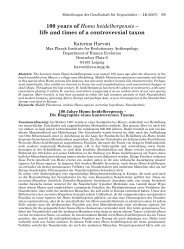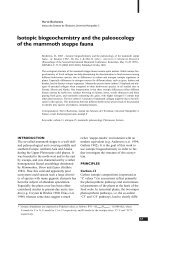bronze age environment and economy in the troad - Universität ...
bronze age environment and economy in the troad - Universität ...
bronze age environment and economy in the troad - Universität ...
Create successful ePaper yourself
Turn your PDF publications into a flip-book with our unique Google optimized e-Paper software.
chapter 3: analysis<br />
3 Analytical results – Sample description<br />
<strong>and</strong> statistical analysis<br />
This chapter provides <strong>in</strong>formation on <strong>the</strong> orig<strong>in</strong> <strong>and</strong><br />
composition of <strong>the</strong> samples. Correspondence analysis was<br />
applied to look for explanatory patterns reflect<strong>in</strong>g <strong>the</strong> Bronze<br />
Age Troians’ economic behaviour (e.g. <strong>the</strong> range crops <strong>and</strong><br />
<strong>the</strong>ir relative importance <strong>in</strong> people’s diet, technical aspects of<br />
agriculture such as <strong>in</strong>tensification, etc.) <strong>and</strong> <strong>the</strong> ecology beh<strong>in</strong>d<br />
it. Fur<strong>the</strong>r <strong>in</strong>terpretation <strong>and</strong> discussion of <strong>the</strong> analytical results<br />
is presented <strong>in</strong> chapters 4 <strong>and</strong> 5.<br />
3.1 Description <strong>and</strong> <strong>in</strong>terpretation of <strong>the</strong><br />
samples<br />
The samples were taken from different archaeological contexts<br />
identified by <strong>the</strong> excavators. The contexts may be of<br />
‛morphological type’ (e.g. burnt layers) <strong>and</strong> functional type<br />
(e.g. ovens). This means that <strong>in</strong> <strong>the</strong> first case <strong>the</strong> context<br />
description does not refer to a specific activity, while <strong>in</strong> <strong>the</strong><br />
second case <strong>the</strong> description implies more or less clearly what<br />
k<strong>in</strong>d of activity was carried out at that location (e.g. cerealprocess<strong>in</strong>g,<br />
stor<strong>age</strong>, cook<strong>in</strong>g, waste disposal, etc.). The<br />
‛functional units’ used here are often related to architectural<br />
objects.<br />
The <strong>in</strong>clusion of <strong>the</strong> ‛functional units’ <strong>in</strong> <strong>the</strong> description of <strong>the</strong><br />
samples, provides additional <strong>in</strong>formation about <strong>the</strong> conditions<br />
under which <strong>the</strong> material was deposited.<br />
Six different ‛function types’ or contexts were dist<strong>in</strong>guished.<br />
1 Floors <strong>in</strong>side <strong>the</strong> build<strong>in</strong>gs, which sometimes conta<strong>in</strong> stor<strong>age</strong><br />
f<strong>in</strong>ds, represent architectural units of <strong>the</strong> surface that <strong>the</strong><br />
people were liv<strong>in</strong>g on. They were well represented <strong>in</strong> all <strong>the</strong><br />
periods from Kumtepe B onwards, but especially <strong>in</strong> Late<br />
Bronze Age contexts. These samples were comb<strong>in</strong>ed with<br />
samples from walls (which were frequently sampled <strong>in</strong><br />
Kumtepe A <strong>and</strong> Early Bronze Age only) <strong>and</strong> o<strong>the</strong>r architectural<br />
objects (e.g. postholes) that were parts of houses <strong>and</strong> related to<br />
floors.<br />
2 ‛Fills’, i.e. sediment layers which are not def<strong>in</strong>ed as floors<br />
but were related to architecture. Many of <strong>the</strong> Early Bronze Age<br />
samples came from fills. ‛Fills’ were layers close to any k<strong>in</strong>d<br />
of wall <strong>and</strong> cannot easily be assigned to a specific activity.<br />
Similarly difficult to <strong>in</strong>terpret <strong>in</strong> terms of <strong>the</strong>ir orig<strong>in</strong> are<br />
rema<strong>in</strong>s from pits, ditches, channels <strong>and</strong> wells as places of<br />
accumulat<strong>in</strong>g waste material. They were often sampled at<br />
Kumtepe <strong>and</strong> <strong>the</strong> samples are usually rich <strong>in</strong> material.<br />
3 Ovens, hearths <strong>and</strong> work<strong>in</strong>g places near ovens are relatively<br />
small, concentrated deposits ma<strong>in</strong>ly with<strong>in</strong> houses, <strong>in</strong> which<br />
<strong>the</strong> rema<strong>in</strong>s of crop <strong>and</strong> food process<strong>in</strong>g had a good chance of<br />
survival. (The few rema<strong>in</strong>s found with<strong>in</strong> fireplaces, however,<br />
were heavily corroded.) Such contexts were well represented <strong>in</strong><br />
Middle Bronze Age <strong>and</strong> Kumtepe B layers.<br />
4 Contents of pottery <strong>and</strong> pithoi were frequent <strong>in</strong> almost all <strong>the</strong><br />
periods except from Kumtepe B <strong>and</strong> Late Bronze Age Troy.<br />
5 Burial contexts were sampled rarely (only <strong>in</strong> <strong>the</strong> Late Bronze<br />
Age) <strong>and</strong> were, as expected, ma<strong>in</strong>ly without botanical rema<strong>in</strong>s.<br />
6 rubble, unknown or not <strong>in</strong>terpretable contexts. The samples<br />
were related to structures, but <strong>the</strong>se deposits were not clearly<br />
def<strong>in</strong>able, <strong>in</strong> terms of function. Most apparently related to <strong>the</strong><br />
construction of foundations or demolition <strong>and</strong> collapse of<br />
build<strong>in</strong>gs. There were many samples from Kumtepe, Late<br />
Bronze Age <strong>and</strong> Post-Bronze Age levels from such contexts.<br />
The proportion of <strong>the</strong> different ‛functional units’ over <strong>the</strong><br />
sequence of periods varies considerably. Floors are ma<strong>in</strong>ly<br />
represented amongst Late Bronze Age samples, fills amongst<br />
Early Bronze Age samples, ovens are very common amongst<br />
<strong>the</strong> samples from Kumtepe B <strong>and</strong> from Middle Bronze Age<br />
Troy, pottery contents appear ma<strong>in</strong>ly <strong>in</strong> samples from Post-<br />
Bronze Age <strong>and</strong> Middle Bronze Age contexts, <strong>and</strong> burials had<br />
significant seed content exclusively <strong>in</strong> Late Bronze Age Troy.<br />
Broadly speak<strong>in</strong>g, <strong>the</strong> Late Bronze Age samples come ma<strong>in</strong>ly<br />
from architectural contexts like floors <strong>and</strong> walls, while <strong>the</strong><br />
Middle Bronze Age samples are ma<strong>in</strong>ly related to food<br />
preparation (ovens, vessel contents). The samples from <strong>the</strong><br />
earlier periods (Early Bronze Age <strong>and</strong> Kumtepe layers) derive<br />
ma<strong>in</strong>ly from waste <strong>and</strong> stor<strong>age</strong> facilities.<br />
For <strong>the</strong> benefit of readers who are not statistically m<strong>in</strong>ded, a<br />
more qualitative description of <strong>the</strong> samples is presented here.<br />
The samples were ma<strong>in</strong>ly selected for contextual reasons, e.g.<br />
when secure archaeological <strong>in</strong>fomation about <strong>the</strong> context was<br />
available. Multiple sampl<strong>in</strong>g of <strong>the</strong> same context was also<br />
noted (for <strong>the</strong> location of <strong>the</strong> Troy samples from <strong>the</strong> Upper<br />
City see Map 2).<br />
3.1.1 The Kumtepe samples<br />
3.1.1.1 Neolithic/Chalcolithic Kumtepe A<br />
In contrast to Kumtepe B samples, which yielded <strong>the</strong> majority<br />
of data from this site, Kumtepe A is restricted to <strong>the</strong><br />
‛bioprofile’ <strong>and</strong> trench F28 with only 7 samples. Two samples<br />
from Kumtepe A came from <strong>in</strong>side a build<strong>in</strong>g. One of those<br />
(BP21) represents <strong>the</strong> possibly disturbed contents of a vessel,<br />
with a species spectrum dom<strong>in</strong>ated by Eragrostis sp. (open<br />
vegetation) <strong>and</strong> with a few cereal rema<strong>in</strong>s. The o<strong>the</strong>r sample<br />
(BP20) seems to be an already cleaned deposit of a crop<br />
legume mixture of lentil <strong>and</strong> bitter vetch <strong>in</strong> a ratio of almost<br />
1:1, close to a wall. The only accompany<strong>in</strong>g weed is Lathyrus<br />
sativus/cicera.<br />
Because only seven samples were obta<strong>in</strong>ed from Kumtepe A<br />
horizons, <strong>the</strong> observable differences between Kumtepe A <strong>and</strong><br />
B samples could be ei<strong>the</strong>r functional or economic <strong>in</strong> nature.<br />
The archaeological <strong>and</strong> archaeozoological results strongly<br />
suggest economic differences (pers. com. M. Uerpmann).<br />
The ma<strong>in</strong> differences <strong>in</strong> archaeobotanical sample composition<br />
between Kumtepe A <strong>and</strong> B are <strong>in</strong> <strong>the</strong> food plants. In <strong>the</strong><br />
Kumtepe A levels, beside fruit trees (fig) <strong>the</strong> gra<strong>in</strong> legumes<br />
(lentil <strong>and</strong> bitter vetch) are most abundant, while cereal crops<br />
are only sparsely recorded. With oysters as ano<strong>the</strong>r ma<strong>in</strong><br />
component of diet, <strong>the</strong> everyday food of <strong>the</strong> Kumtepe A people<br />
can be described as very rich <strong>in</strong> prote<strong>in</strong>s <strong>and</strong> <strong>in</strong> ‛low quality’<br />
carbohydrates. Such a diet may be reflected <strong>in</strong> <strong>the</strong> dental health<br />
of <strong>the</strong> Kumtepe A population.<br />
27




